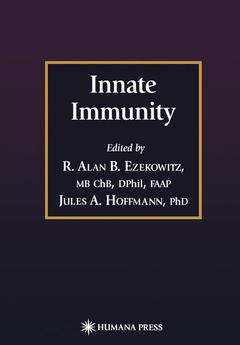Innate Immunity, 2003 Infectious Disease Series
Langue : Anglais
Coordonnateurs : Ezekowitz R. Alan B., Hoffmann Jules A.

The concept of innate immunity refers to the first-line host defense that serves to limit infection in the early hours after exposure to microorganisms. Recent data have highlighted similarities between pathogen recognition, signaling pathways, and effector mechanisms of innate immunity in Drosophila and mammals, pointing to a common ancestry of these defenses. In addition to its role in the early phase of defense, innate immunity in mammals appears to playa key role in stimulating the subsequent clonal response of adaptive immunity. Recent exciting information has determined that the templates that are laid down in primitive life forms, like flowering plants and insects, form the basic principles of first line host defense that are conserved in mammalian systems. The next frontier in the field is to understand the dynamic adaptive changes that occur as a result of the inter play between host defenses and infectious agents. One emerging theme is that microorganisms are constantly seeking ways to co-opt host defenses. On the other hand, host defense to infection is mediated by the coordinate action of pattern recognition molecules and receptors that, in mammals, are important and probably necessary antecedents to the development of an adaptive immune response. Innate Immunity aims to explore the intersection between host pathogen interactions across an evolutionary spectrum that will inform our understanding of the dynamic interplay between infectious agents and host defense in man.
SECTION I: Plant Immunity.- 1 Pathogen Recognition and Signal Transduction in Plant Immunity.- 2 Plant Disease Resistance Genes.- 3 Nonhost Resistance in Plants to Microbial Pathogens.- SECTION II: Invertebrate Host Defense Immunity.- 4 Regulatory Co-options in the Evolution of Deuterostome Immune Systems.- 5 Antimicrobial Peptides in Insect Immunity.- 6 Innate Immunity in the Horseshoe Crab.- 7 Pattern Recognition Receptors in Drosophila.- 8 Humoral and Cellular Responses in Drosophila Innate Immunity.- 9 Thioester-Containing Proteins of Protostomes.- SECTION III: Mammalian Host Defenses: Pattern Recognition Receptors.- 10 Toll-Like Receptors.- 11 The Macrophage Mannose Receptor and Innate Immunity.- 12 Diverse Roles of Lung Collectins in Pulmonary Innate Immunity.- 13 Structures of Complement Control Proteins.- 14 Lipopolysaccharide-Binding Protein and CD14.- SECTION IV: Mammalian Host Defenses: Links Between Innate and Adaptive Immunity.- 15 The Role of Chemokines in Linking Innate and Adaptive Immunity.- 16 Antimicrobial Peptides.- 17 The Role of Complement in Innate and Adaptive Immunity.- 18 The Role of Natural Killer Cells in Innate Immunity to Infection.- 19 Innate Immune Signaling During Phagocytosis.- 20 The Role of Mast Cells in Innate Immunity.- 21 CD1-Restricted T-Cells.
Includes supplementary material: sn.pub/extras
Date de parution : 08-2012
Ouvrage de 410 p.
17.8x25.4 cm
Date de parution : 12-2002
Ouvrage de 410 p.
17x25 cm
Thème d’Innate Immunity :
Mots-clés :
© 2024 LAVOISIER S.A.S.



